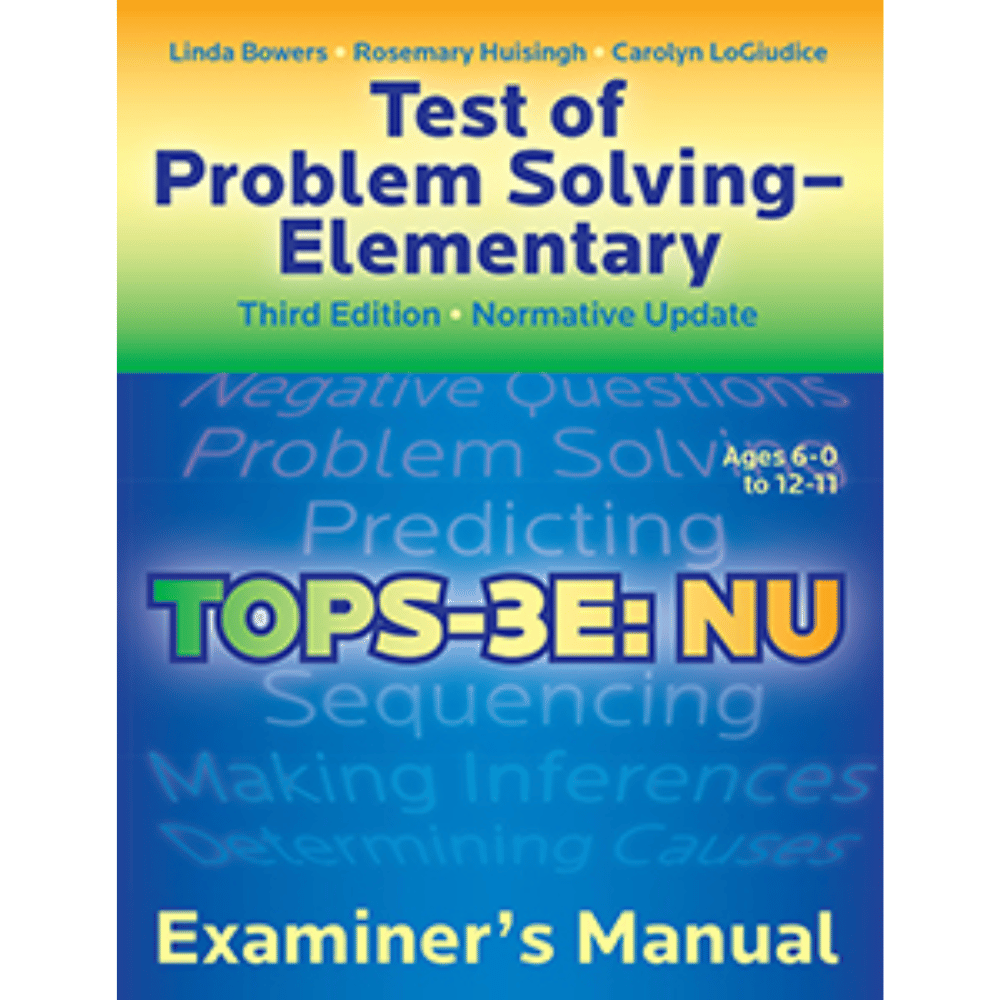TOPS-3E: NU: Test of Problem Solving (Elementary), Third Edition, Normative Update
TOPS-3E: NU: Test of Problem Solving (Elementary), Third Edition, Normative Update
Grades K - 7 | Ages 6 - 12
SKU:#34282
Couldn't load pickup availability
- We Accept Purchase Orders!
- Fully Secured SSL Checkout
- 30-Day Return Policy
Share
The TOPS-3E: NU assesses a school-age child's ability to integrate semantic and linguistic knowledge with reasoning ability through picture stimuli and verbal responses.
Ages: 6-0 through 12-11
Testing time: 35 minutes
Administration: Individual
Accurately Assess Language-Based Thinking
The TOPS-3E: NU focuses on students' linguistic ability to think and reason. Language competence is the verbal indicator of how a student's language skills affect his ability to think, reason, problem solve, infer, classify, associate, predict, determine causes, sequence, and understand directions. The test focuses on a broad range of language-based thinking skills, including clarifying, analyzing, generating solutions, evaluating, and showing effective thinking.
While other tests may asses students' thinking skills by tapping mathematical, spatial, or nonverbal potential, the TOPS-3E: NU measures discreet skills that form the foundation of language-based thinking, reasoning, and problem-solving ability.
Although the skills tested on the TOPS-3E: NU are necessary for developing social competence, it is not primarily a test of pragmatic or social language skills. Rather, it should be part of a battery of tests and observations used to assess pragmatic competence.
New Features of Test of Problem Solving (Third Edition)
- Characteristics of the normative sample were stratified by age relative to region, gender, ethnicity, and socioeconomic factors, and other critical variables are the same as those reported for the school-age population reported the ProQuest
- Statistical Abstract of the United States, 2016 (ProQuest, 2016).
- The Total Score was renamed the Problem-Solving Index and calculated as a standard score with a mean of 100 and a standard deviation of 15.
- Each item on the test was evaluated using both conventional item analysis to choose good items and differential item analyses to find and eliminate potentially biased items.
- The index score was thoroughly examined for floor and ceiling effects.
- The test was subjected to diagnostic accuracy analyses, particularly rigorous techniques involving the computation of the receiver operating characteristic/area under the curve (ROC/AUC) statistic.
- The Examiner's Manual was reorganized and rewritten to provide more detailed information on the test's administration, interpretation, and statistical characteristics.
What is included in the TOPS-3E: NU Test?
The TOPS-3E: NU has three components: an Examiner's Manual, Examiner Record Booklets, and a Picture Book.
- The Examiner's Manual includes a comprehensive discussion of the test's theoretical and research-based foundation, item development, standardization, administration and scoring procedures, norm tables, and guidelines for using and interpreting the test's results.
- The Examiner Record Booklet provides space to record responses and transform the raw score to an age equivalent, percentile rank, and the Problem Solving Index.
- The test kit also includes a Picture Book, which provides the picture stimuli for the test items.
Reliability and Validity
- Reliability and validity studies were conducted with individuals who have typical language ability and individuals who had been previously diagnosed with a language impairment or received other special education services. The average coefficient alpha is .82 for the Problem Solving Index.
- Studies were conducted to examine the ability of the test to differentiate students who receive special education services or have language impairments from those who do not.
- The results demonstrate that a Problem-Solving Index cutoff score of 90 resulted in a sensitivity of .75, a specificity of .85, and a ROC/AUC of .74 for differentiating students who receive special education services; and a cutoff score of 92 resulted in a sensitivity of .69, a specificity of .89, and a ROC/AUC of .73 for differentiating students who have a language impairment.
- The validity of the test composites was demonstrated by correlations to the Universal Nonverbal Intelligence Test- Group Abilities Test (UNIT-GAT; Bracken & McCallum, in development).
- The coefficient for the Analogic Reasoning subtest was .73, and the coefficient for the Quantitative subtest was .89, both very large.
The Complete TOPS-3E: NU Includes:
- Examiner's Manual
- Picture Book
- 25 Examiner Record Booklets
- Sturdy storage box
©2018




